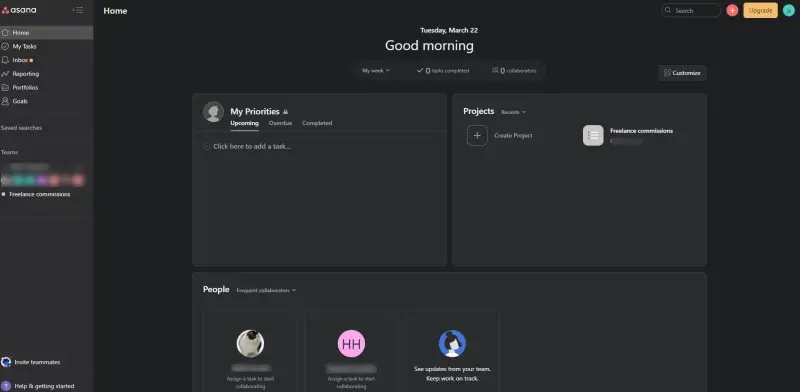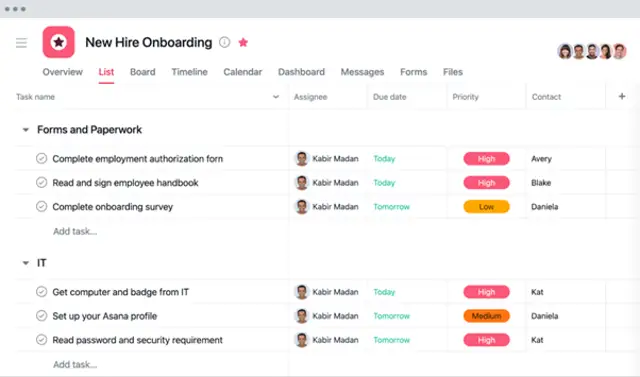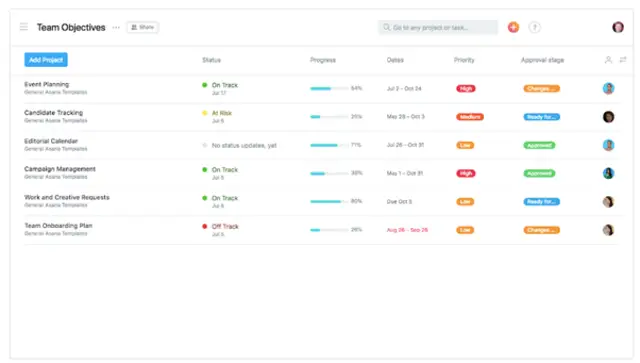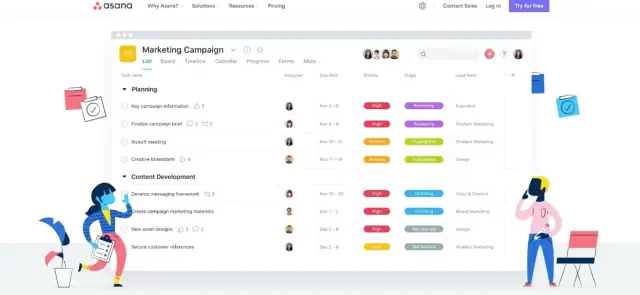
Are you trying to decide which of these top project managment services to get and want to compare Asana vs Monday? We've used both of them and can give you the run-down so that you can decide which makes sense for you.
(To be honest, it makes sense to get a trial of both and see which is a good fit, but we'll give you the details anyway...)
"Let our advance worrying become advance thinking and planning." ~ Winston Churchill
As projects become more complex throughout time, a variety of project management tools arose to meet the demands of project managers.
Asana and Monday have emerged as market leaders among the hundreds of project management software programs available. Both of these software programs are web-based services that store data in the cloud.
But which is more beneficial: Monday or Asana?
I believe I am qualified to decide the "Asana vs Monday" dispute once and for all as a project management specialist with more than 10 years of expertise.
Here are my thoughts on both tools.
{autotoc}
What is Monday.com?
Monday.com is a cloud-based application development software that provides global enterprise solutions to professionals.
The software also features a Project Management suite that allows customers to consolidate all project management steps in one place.
In a word, Monday is a platform that allows teams to manage tasks collaboratively, collaborate on every step of the project, see progress through data, scheduling options, and performance settings, and keep everything in one place.
The software also has connectors that make apps like Monday essential for teams working in a fast-paced setting.
What is Asana?
Asana is a cloud-based project management software that is tailored to the demands of small and medium-sized businesses.
Task management, collaborations, portfolio management, and workflow management are all handled by the software.
Calendars, lists, Gantt charts, and Kanban Boards can all be used to track the progress of your project. Additionally, you may collaborate with your team utilizing Asana's integrated communication capabilities.
Asana is widely utilized as a project management tool around the world due to its ease of use.
We've also compared Trello vs Asana if you're interested in such a comparison.
Asana vs Monday.com : Features
First off, let’s take a look at the most important features side-by-side:
|
Comparative Benchmark |
Asana |
Monday |
|
Views and Features |
The major views board, Gantt charts, and Calendar are the three main views of Asana. Portfolio management tools are among the many collaboration and management options available. |
Lists, Kanban boards, and timelines are among the three basic options available on Monday. Workflow management based on geography is one of the standout features. |
|
User Interface |
Asana has a convenient user interface, but a newbie can get stuck with the number of functionalities it offers. |
A dynamic and colorful user interface with a single view option that allows you to organize multiple items in a single view. However, the same problem of too many functionalities complicates usage for a novice user. |
|
Team Management and Communication |
Asana allows up to 15 people to work together. You can use integration to ensure that your team communicates effectively. |
In the free version, you can only have two team members. Integrations may help a team communicate more effectively. |
|
Integrations |
More than 200 integrations are available. |
More than 50 integrations are available. |
|
Pricing |
Asana's pricing is divided into three categories: Basic, Premium, and Business. The Basic version is available for free. The Premium Account costs $10.99 per month per person, while the Business Account costs $24.99 per month per person. |
Monday operates on a four-tiered pricing structure. Individual – Free Basic – $8 per seat per month $10 per month per seat is the standard rate. Pro-$16 per seat per month Enterprise- customized prices that meet business needs. |
To give you a better idea of what each tool has to offer, here’s a Monday vs Asana feature comparison.
1. Workflow Management

Workflow can be managed in Asana by using different 'view' categories. Lists, boards, and timelines are among the available views.
The workflow is depicted in a variety of ways in each of these views. To see the workflow, drag and drop tasks to the view you want to see it in.
At Asana, here's a list view:
Similarly, if you want, you can view your project as a Kanban board.
Asana has a workflow management system that is almost identical to Monday.com's. In comparison to Asana, it is easier to switch between different visual project workflow units. You can learn more about monday.com's workflow management software here.
You can manage the workflow with Monday.com's Kanban boards, charts, and timelines.
A Kanban chart is a visual representation of a team's workflow. You can see the list view of every project step in the form of pulses on Monday.com.
Furthermore, the user interface makes it simple to switch between pulses. The default view is a list, but you can switch to a Kanban board or a chart for a more visual representation of your workflow.
2. Task Management

In Asana, task management entails creating tasks, setting task goals such as deadlines, assigning tasks to team members, and tracking tasks using lists, boards, and the timeline view.
The to-be-completed-soon tasks can be found in the 'My task' tab on the home page. You can also view all of the task details and attach documents for collaboration by clicking on any task.
This is a timeline view of Asana's task management. As you can see, different project tasks are assigned to different team members.
Monday.com has a similar task management system, but the tasks are referred to as pulses. You can create pulses, assign them to team members, and link them to task dependencies.
You can also keep track of the task's progress in your task manager by looking at the task overview. The task statuses keep the team informed about the task's progress.
You can also use the software to keep track of daily to-do lists and weekly team tasks. The team leader can create tasks and assign them to the members of the team.
The action boards provide a quick overview of each task's status, making task management simple for team members.
3. Portfolio Management

Unlike many other PM tools, Asana and Monday both offer Portfolio Management. Portfolio management is the coordination of all ongoing projects in one location.
Here's how both tools go about doing it:
By zooming out of the day-to-day tasks in Asana, you can see the portfolio of ongoing projects. The portfolio displays the current status of each project, ensuring that you do not miss any deadlines due to juggling multiple projects at the same time.
Unlike Asana, Monday does not have a dedicated portfolio management section. Monday, on the other hand, has a feature called 'Groups,' which you can use to group any of your project's sub-benchmarks.
You can create a portfolio tab by combining all of your current projects in one place using the group tool.
The groups, unlike Asana, do not show you the complete status of the projects. You can, however, keep track of the projects by creating a group (at least you can avoid forgetting a project completely).
4. Security
All enterprise-based solution providers are concerned about digital security. Asana and Monday, on the other hand, have both secured their customers through reputable security compliances.
Asana is SOC 2 and ISO/IEC 27001:2013 compliant. The company does not grant businesses the right to run the software on their servers.
They've kept it cloud-based and have firewalls in place to protect their clients' information.
Monday.com collaborates with Amazon Web Service to keep customer data accessible (AWS).
Monday also makes use of the Google Cloud Platform's security practices. Furthermore, the company has met the requirements of ISO 27001 and ISO 27018.
In short, both platforms take the security of their users' data very seriously.
5. Integrations

Asana has more than 150 integrations with business software. To better organize your work, you can use Slack, Instagantt, Dropbox, and Google Drive. You can also take advantage of a powerful Everhour integration for time tracking and budgeting:
Asana is ahead of Monday in terms of integrations, with nearly 50 workspace solution providers. While using Monday, you can use Zoom, Google Drive, Excel, and other programs.
Monday vs Asana: Pricing
Asana operates on a three-tiered pricing structure. The basic plan is free and includes the three views mentioned above, as well as basic workflows and reporting.
Up to 15 team members can be included in the free version. Custom fields, unlimited dashboards, and unlimited reporting across unlimited projects are all included in the Premium account, which costs $10.99 per month.
The most expensive plan is the business plan, which costs $24.99 per month per user. Advanced reporting options and four views are included, compared to three views in the lower-priced options.
In comparison to Asana, Monday is a little less expensive. Customers can choose from five different pricing tiers. Individual membership is free and includes up to two members, unlimited boards, and over 200 templates.
The monthly cost of the basic plan is $8 per person. Then there's a basic account, which costs $10 per person per month. The Pro account costs $16 per month, and enterprise solutions are priced differently depending on the package.
Overall, Monday's pricing is better than Asana's. However, if you prefer a free option, Asana is the clear winner.
Pros and Cons of Using Asana
- User-Friendly Interface: Asana has an intuitive and easy-to-use interface that even beginners will find simple to use.
- Customization: Almost every function you perform in Asana can be customized.
- Integrations: Asana is a favorite among businesses thanks to its over 150 integrations.
- Multiple Views: Asana users can customize their views based on their preferences. They can see lists, timelines, boards, and timelines, for example.
- Collaboration among teams: Teams can communicate in a single location.
- There isn't a single view for all tasks, so you'll have to switch between tabs to manage everything.
- A Single Task Cannot Have More Than One Assignee: A task cannot have more than one assignee.
- The Software is Expensive: Small businesses may find the pricing plans to be prohibitively expensive.
Pros and Cons of Using Monday
- Monday has a vibrant and colorful display that can cheer anyone up if you look at the user interface.
- Multiple Departments Can Collaborate: Monday makes tracking tasks and projects for the inter-departmental team simple.
- Monday.com, unlike Asana, allows you to assign a single task to multiple people.
- Multiple Integrations: The tool's over 50 integrations allow it to do a lot more than the built-in features.
- An interface that is easy to use. Monday, like Asana, has an intuitive interface that makes it simple to use even for beginners.
- Functionalities that are related to the task You will require training before you can begin working on Monday.com. Due to the complexity of task management, it requires training if you work in an enterprise setting.
- Team Members Aren't Allowed in the Free Plan: For Monday.com's free plan, the maximum number of team members is two, which is practically useless if you're managing teams.
Other Alternatives
Other than Monday.com and Asana, there are other project management software tools you can use. Some other excellent options include:
- Jira (which we compared to Asana)
- Trello
- Nifty
- Workfront
All of these software programs have advantages and disadvantages, and it's important to remember that no software is perfect. Whatever project management tool you choose, your team will need to adjust to something.
Asana vs Monday Debate: the Bottom Line
This comparison of Asana vs Monday reveals that both software programs have some advantages and disadvantages. Asana performs slightly better than Monday.com in terms of integrations and customization. Monday.com, on the other hand, takes the lead in terms of pricing and user interface.
Both project management tools are geared toward small and medium businesses and have a similar structure. It all comes down to personal preference and organizational requirements at the end of the day. I hope this review assisted you in determining which project management tool is best for you.
Asana vs Monday FAQs
What is the difference between Asana and Monday.com?
The main difference between Asana and Monday.com is when it comes to integrations. Asana has many more integrations with 3rd party companies. We would suggest looking at the software you use and see whether there is an integration for it. There is slight difference in price too which should not make too much of a difference unless you have hundreds of users.
What does Monday.com have that Asana doesn't?
Monday has more features and views options than Asana offers overall. Monday also offers 24/7 customer support with an average response time of less than 60 minutes which is great if your business is going to depend on it. Monday has hundreds of ready-made templates that can be used for various types of projects. The ability to create, customize, and share forms with your team members and clients is also a crucial feature.
Is Asana free forever?
Asana has a free plan supports unlimited teams, projects, messaging, activity logs, file storage, multiple project views, and more. If you have less than 15 users and manage basic projects, you'll never need to upgrade and can stay on the free plan forever. This is a major selling point for small companies. In reality, when your company grows, you'll have to upgrade but at that point you're getting more than enough value from the platform.
